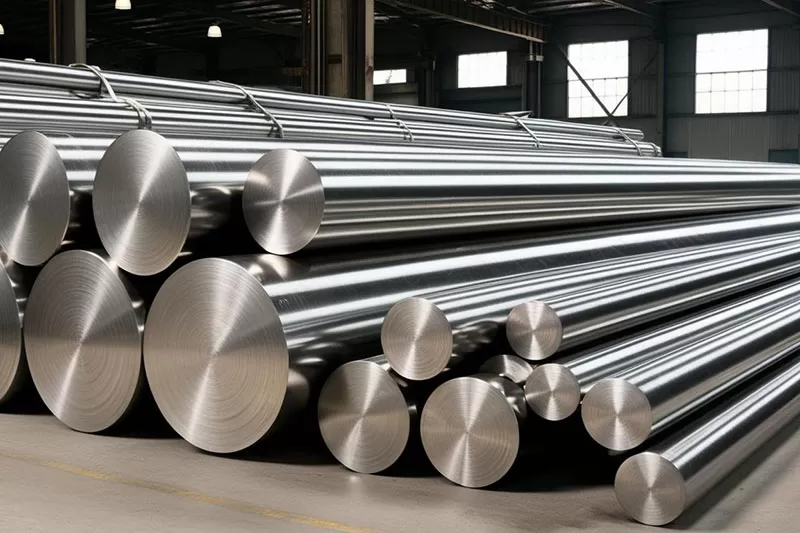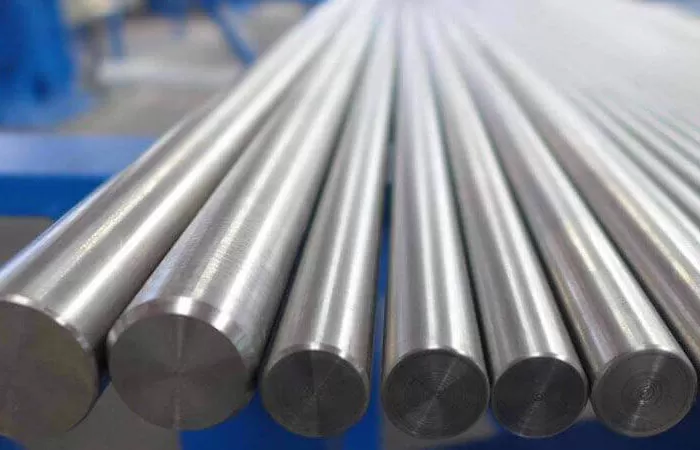
Inconel 718 has been called the “workhorse” of nickel superalloys, and with good reason. In bar form, it carries the loads of landing gear trunnions, bolts and shafts in turbines, oil-and-gas completion hardware, high-temperature fasteners, and cryogenic valves. What makes 718 bars so versatile is not any single property but a systems-level harmony among composition, melt practice, deformation schedule, heat treatment, and inspection. This article follows one heat of 718 from melting to deployment, showing how each decision along the way sculpts microstructure—and, ultimately, performance.
Bar stock sits at a sweet spot between flexibility and reliability. Compared with near-net-shape forgings, bars allow fast turnaround and economical inventory; compared with billet, they offer tighter dimensional control and more uniform properties through cross-section. Machinists can saw, turn, mill, thread, and grind bars into everything from slender pins to complex valve stems. The microstructural target is consistent: a fine, equiaxed γ matrix strengthened by a balanced precipitation of γ′ (Ni₃(Al,Ti)) and γ″ (Ni₃Nb), with delta (δ, Ni₃Nb) controlled so it stabilizes grain size but does not rob strength. That target sounds straightforward; hitting it repeatedly is not.
Inconel 718 is a Ni-Fe-Cr-Nb-Mo-Ti-Al alloy. Niobium is the star—driving the formation of γ″, the phase most responsible for 718’s high yield strength. But Nb is also a trickster: too much and you invite coarse, interdendritic Laves phases during solidification that must later be broken up; too little and the aging response weakens. Aluminum and titanium tune γ′; molybdenum deepens solid-solution strength; chromium sets the corrosion and oxidation baseline; and carbon and boron—kept very low—shape grain-boundary cohesion and carbide morphology. The best producers treat the chemistry window as guardrails, then drive within it to a “house recipe” optimized for their casting thermal gradients, remelt practice, and hot-work schedules. That recipe isn’t static; it evolves with scrap streams, furnace upgrades, and product mix.
Most premium 718 bars originate in vacuum induction melting (VIM) followed by vacuum arc remelting (VAR). VIM allows tight chemistry, low dissolved gases, and controlled deoxidation. VAR acts as a “macro-cleaner,” reducing segregation and shrinking inclusion populations by controlled re-solidification. Some mills add electroslag remelting (ESR) to tune inclusion shape and sulfur control. The point is not brand-name metallurgy but defect probability reduction: every remelt step lowers the likelihood that an inclusion, segregation streak, or shrinkage cavity will line up with a future fatigue hotspot. In bar products destined for rotating hardware or flight-critical fasteners, that risk delta is the difference between routine service and premature retirement.
Hot working converts the solidification microstructure to something usable. For 718, the forging/rolling window typically sits below the δ-solvus to leverage dynamic recrystallization while avoiding excessive δ precipitation during slow cooling. The exact strain-temperature-time path controls:
Grain size and spread. Finer grains raise yield strength and low-cycle fatigue life; too fine, and creep resistance may suffer.
Laves dissolution and redistribution. Early, high-strain passes break up interdendritic Laves eutectic and drive homogenization.
Texture. For bars, a mild <111> fiber texture is common; extreme texture can seed anisotropy in mechanical properties.
Intermediate normalizations may be inserted to reset grain size. The best mills monitor reduction per pass, strain rate, and finishing temperature with closed-loop models, not only to hit diameter and straightness, but to aim at a “microstructural window” whose location shifts with size, chemistry, and downstream heat treatment.
In 718 bars, heat treatment typically involves a solution anneal followed by a two-step age. The solution step dissolves enough Nb-bearing phases to enable a uniform precipitation response; the double age builds the γ′/γ″ population that carries strength into service.
Solution anneal. Often near ~980 °C (values vary by specification and section size) to strike a balance: high enough to dissolve detrimental phases, low enough to retain grain size control and avoid excessive δ dissolution that could allow grains to grow later.
Aging. A canonical schedule is a first hold in the ~700–725 °C range to precipitate γ″, then a controlled furnace cool into the ~600–650 °C range for secondary precipitation and stabilization.
Timing, ramp rates, and soak uniformity matter as much as the setpoint. Sections thicker than ~75 mm can require longer soaks or modified schedules to avoid center-to-surface property gradients. Smart furnaces now use thermometric twins and model-based control to equalize thermal histories between small and large lots, so the same spec numbers yield the same metallurgy.
Bars are born with surfaces that tell a story: scale from hot working, shallow decarburization (minimized in Ni alloys but not zero), and minor mechanically transferred debris. Post-processing—peeling, centerless grinding, or turning-and-polishing—creates the contact surface that parts “inherit.” For high-cycle fatigue, that inheritance is decisive. A 16 µin Ra surface with shallow compressive residual stress vastly outperforms a scratched surface with smeared laps. Shops that thread 718 bars appreciate this: roll threading on properly prepared stock can stack compressive stresses, reducing the notch penalty; cut threading on poorly prepared stock can introduce micro-notches that defeat the alloy’s inherent toughness.
Ultrasonic testing screens for internal reflectors; eddy current probes the near-surface; magnetic particle is inapplicable to non-ferromagnetic 718, so dye penetrant finds surface-breaking anomalies. The goal is not “zero defects”—a mirage—but risk budgeting: aligning NDT sensitivity with the part’s damage tolerance and size. A hydraulic fastener might accept a different echo threshold than a rotor tie bolt. Equally important is process capability: controlling straightness and surface so UT coupling is reliable, calibrating on realistic reflectors, and qualifying operators against false calls that clog the line or, worse, misses that seed failures.
Even in solution-treated condition, 718 is sticky and work-hardens. In aged condition, it’s a different beast—abrasive and energy-hungry. Winning strategies in bar-to-part conversion include:
Chip control by design. Positive-rake carbide geometries, honed edges to avoid micro-chipping, and strong chip breakers to keep heat off the tool nose.
Thermal discipline. Flood coolant aimed at the shear zone, not just bathing the tool; avoid rubbing passes that glaze the surface.
Adaptive paths. Constant-chip-load toolpaths in milling; consistent depth of cut to stay below the hardened layer.
Finishing finesse. Spark-out grinding minimized; if used, follow with light polishing or burnishing to restore compressive surface stress without overheating.
With bars, one extra variable enters: bar straightness. Whip at high spindle speeds can modulate chip thickness and destroy tools. Quality bar producers treat straightness not as a dimensional nicety but as a machining enabler.
The δ phase is a paradox. A little at grain boundaries pins grains and improves creep-fatigue resistance; too much drains Nb from γ″ and lowers tensile strength. The clever trick in bars is using deformation and cooling rates to precipitate just enough δ in the right places. That’s why seemingly identical heat-treat schedules can deliver different results across mills: they ride on different deformation histories. The microstructure is a palimpsest; heat treatment writes over hot-work “text,” but never fully erases it.
Nickel superalloys are energy-intensive. Forward-looking mills reduce impact by maximizing revert scrap usage without compromising cleanliness, optimizing furnace utilization with model-based scheduling, and investing in low-carbon power for remelt operations. Bars are good vehicles for sustainability because they consolidate demand across many small parts. A single 100-mm-diameter bar turned into twenty flight-critical bolts represents a concentrated quality investment spread across a fleet.
The next frontier in 718 bars is not purely metallurgical; it’s informational. Imagine each bar carrying a digital process twin: melt chemistry, inclusions per mm², reduction-per-pass history, thermal curves, and NDT maps. Downstream users could correlate that fingerprint with machining power signatures and in-service strain gage data, refining purchase specs from “AMS-compliant” to “AMS-compliant with demonstrable low-angle boundary density below X and Laves-fragment size distribution below Y.” When data becomes part of the product, suppliers can differentiate beyond price and lead time.
What begins as a carefully melted and rolled cylinder becomes a component that resists fatigue at 400 °C, holds torque after thousands of cycles, and shrugs off chloride splashes on a coastal platform. The magic is not magic; it’s disciplined control of phases, inclusions, grain size, residual stress, and surface integrity. Inconel 718 bars are proof that, in advanced metallurgy, performance is a system property. Treat the system well at every step, and the bar will treat the mission well for years to come.

2025-12-11 16:42:29

2025-11-19 14:09:22

2025-11-07 17:27:49

25th floor, C3 Building, Wanda Plaza, Kaifu District, Changsha, Hunan Province, China